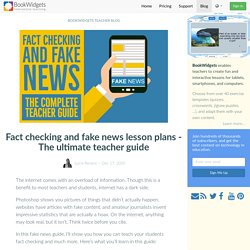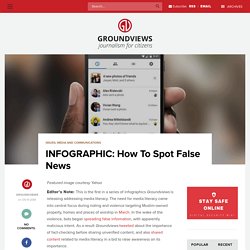

Mozilla's New Project TheirTube Allows Users to Experience How YouTube's Landing Page Looks for Six Personas. You may have seen social media posts from your climate-change-denying friends or ultra-liberal friends, and have wondered how they came to some particular conclusions.

Mozilla’s new project offers a glance at theoretical YouTube homepages for people in six categories. The new project called TheirTube was created by an Amsterdam-based creative developer Tomo Kihara. Mozilla created suggestion bubbles for six personas based on interviews with real YouTube users. The new project presents the YouTube landing page from the viewpoint of six personas including prepper, liberal, climate denier, conservative, conspiracist, and fruitarian.
Mozilla hopes to demonstrate how the recommendation algorithm of YouTube could confirm some particular biases. Six lessons from my deepfake research at Stanford – JSK Class of 2019. Fact checking and fake news lesson plans - The ultimate teacher guide. The internet comes with an overload of information.

Though this is a benefit to most teachers and students, internet has a dark side. Photoshop shows you pictures of things that didn’t actually happen, websites have articles with fake content, and amateur journalists invent impressive statistics that are actually a hoax. On the internet, anything may look real, but it isn’t. Factitious. Vad visar bilden. Bad News. Factitious - A Game That Tests Your Ability to Spot Fake News. Factitious is a game for testing your skill at identifying fake and misleading news stories. The game was developed by the American University Game Lab and the American University's School of Communication. I learned about the game last month when Larry Ferlazzo featured it and I have since shared it in a couple of professional development workshops.
It was a hit in both workshops in which I shared it with teachers. To play Factitious simply go to the site and select quick start. You'll then see an article appear on the screen. Factitious does offer the option to create an account to save your progress in a game, but you don't need to create an account in order to play the game in "quick start" mode. Applications for EducationFactitious could be a great game to have students play at the conclusion of a larger lesson about evaluating the credibility of websites. INFOGRAPHIC: How To Spot False News – Groundviews.
Featured image courtesy Yahoo Editor’s Note: This is the first in a series of infographics Groundviews is releasing addressing media literacy.

The need for media literacy came into central focus during rioting and violence targeting Muslim-owned property, homes and places of worship in March. In the wake of the violence, bots began spreading false information, with apparently malicious intent. As a result Groundviews tweeted about the importance of fact-checking before sharing unverified content, and also shared content related to media literacy in a bid to raise awareness on its importance. View the full size infographic below. Falska nyheter i nytt skolmaterial.
Hur kritiskt granskar du det du delar på nätet?

Fake News Is Here: Help Students Detect It. By Frank W.

Baker “Dewey Defeats Truman” read the large font headline on the front page of The Chicago Daily Tribune for the issue published the night of the 1948 presidential election. The headline was wrong: Harry Truman HAD won. The paper went to press before the final votes were counted. Truman, on a whistle-stop train tour, famously held up the erroneous headline, with a big smile on his face. How to tell fake news from real news. In November 2016, Stanford University researchers made an alarming discovery: across the US, many students can’t tell the difference between a reported news article, a persuasive opinion piece, and a corporate ad.

This lack of media literacy makes young people vulnerable to getting duped by “fake news” — which can have real consequences. Want to strengthen your own ability to tell real news from fake news? Start by asking these five questions of any news item: Fake news. It's complicated. – First Draft News – Medium. What can we do?

We all play a crucial part in this ecosystem. Every time we passively accept information without double-checking, or share a post, image or video before we’ve verified it, we’re adding to the noise and confusion. The ecosystem is now so polluted, we have to take responsibility for independently checking what we see online. In the weeks after the US election, we saw journalists track down fake news creators. The complete list of all 33 false things Donald Trump has said as president so far. Fake news. It's complicated. - First Draft News. This article is available also in Deutsch, Español, Français and العربية By now we’ve all agreed the term “fake news” is unhelpful, but without an alternative, we’re left awkwardly using air quotes whenever we utter the phrase.

The reason we’re struggling with a replacement is because this is about more than news, it’s about the entire information ecosystem. And the term fake doesn’t begin to describe the complexity of the different types of misinformation (the inadvertent sharing of false information) and disinformation (the deliberate creation and sharing of information known to be false). [infographic] Fake news or real news? 10 tips to getting the facts for yourself - Stone Soup Creative. I read a good article today on NPR’s All Tech Considered, Fake Or Real?
![[infographic] Fake news or real news? 10 tips to getting the facts for yourself - Stone Soup Creative](http://cdn.pearltrees.com/s/pic/th/infographic-yourself-creative-149188769)
How To Self-Check The News And Get The Facts. Except I figure people who aren’t schooled in figuring out the difference aren’t likely to be reading an NPR article. So I quickly put together this infographic based on the article and a link provided to a google doc, False, Misleading, Clickbait-y, and/or Satirical “News” Sources, prepared by Melissa Zimdars, an assistant professor of communication and media at Merrimack College.
Real or fake news - Jane Lambourne. Fake It To Make It. I'm so glad you asked!

There are a number of good articles on how to identify fake news, including this one from FactCheck.org: How to Spot Fake News. In addition, please: Do your research before sharing! If you see something questionable, look it up! Sometimes, just a quick Google search is enough. Consider your sources. Ask yourself if someone is benefiting by manipulating your emotions. This Is Not Fake News (but Don’t Go by the Headline) - NYTimes.com. Synthesizing Obama: Learning Lip Sync from Audio. Bad News. Blue Feed, Red Feed. What is this?
Recent posts from sources where the majority of shared articles aligned “very liberal” (blue, on the left) and “very conservative” (red, on the right) in a large Facebook study. In 2015, the journal Science published a research paper by Facebook scientists (Bakshy, Eytan; Messing, Solomon; Adamic, Lada, 2015, “Replication Data for: Exposure to Ideologically Diverse News and Opinion on Facebook”, Harvard Dataverse, V2) which looked at how a subset of the social network’s users reacted to the news appearing in their feeds.
For six months, Facebook tracked and analyzed the content shared by 10.1 million of its users (who were anonymized). These users had identified their political views in their own profiles on Facebook. Analyzing these users’ political labels, the researchers categorized each as very liberal, liberal, neutral, conservative or very conservative. Are you saying these sources are conservative and liberal? How to tell fake news from real news. Fake news. Filterbubblor och falska nyheter – Digidelat – Medium.